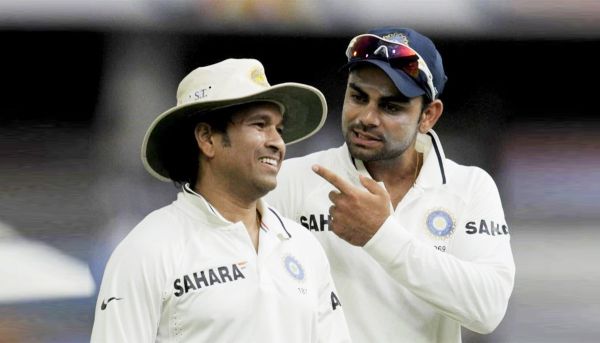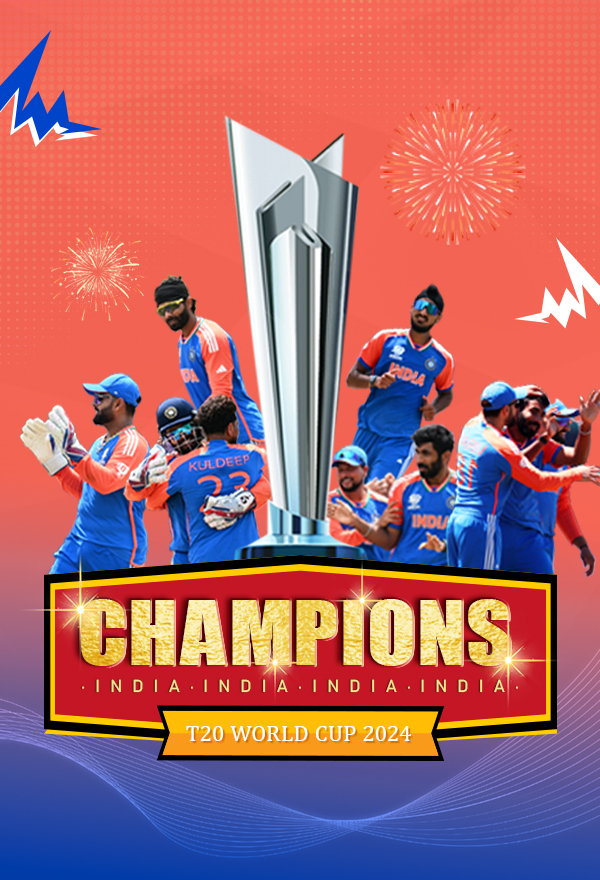
From Tendulkar to Kohli: The evolution of cricket’s Fab Four and beyond
sanjeev
khelja|18-10-2024
Cricket, like all great sports, has seen its pantheon of legends rise and inspire generations of fans. For me, the journey into cricket fandom began with India's ill-fated tour of Australia in 1991-92, a series etched in the collective memory for reasons both bitter and sweet.
During those times, India was far from being a formidable force on foreign soil, a pale shadow of the impressive team it is in today's times. The team's 4-0 loss in the Test series, coupled with an uninspiring showing in the Benson & Hedges Finals (the famous one day series Down Under, of the late 1980s & early 1990s), was a stark reminder of the gap between India and the world's best teams.
However, even in the gloom, the bright spark of a teenage sensation-Sachin Ramesh Tendulkar-captured the hearts & minds of fans worldwide.
At just 18 years of age, Tendulkar had already begun to showcase the genius that would define his career for over two decades. His unerring technique, combined with a temperament that belied his youth, made him a crowd favorite.
It was clear that the boy from the Maidans of Mumbai was destined for greatness, and during the tour of 1991-92 Down Under, Sachin's innings of 148 not out at Sydney and 114 at Perth (the old WACA ground), considered one of the most challenging wickets in the world, were glimpses of the brilliance that would soon define Indian cricket. After the splendid century at Perth, Merv Hughes said to Allan Border, “A B, this little prick's going to get more runs than you."
The birth of a 'Prince' Down Under!
The year 1992 was notable for another significant development in cricket history-it marked the first Cricket World Cup played with colored clothing and white balls.
Australia, long the innovators in the sport, had been at the forefront of these changes. Kerry Packer's World Series Cricket in the late 1970s had introduced the idea of night matches, colored kits, and white balls, while the World Championship of Cricket in 1985, which India famously won, solidified the appeal of the new format.
The 1992 World Cup was a watershed moment in cricket's evolution, as it not only showcased modern cricket, in the biggest stage of all - The World Cup, but also introduced a new generation of stars.
Among them was Brian Charles Lara, a left-handed dynamo from Trinidad and Tobago who lit up the tournament with his extravagant stroke play. Lara, with his high backlift and typical Caribbean flair, would soon be considered one of the greatest batsmen of his era, forming an unofficial batting rivalry with Sachin Tendulkar. Together, they would dominate the cricketing conversation throughout the 1990s. While Lara demonstrated considerable prowess in the ODI format, it was the test format where he truly excelled. His numerous rescues of the West Indies team during a period of decline from their dominant position in the 1980s are particularly memorable.
A year subsequent to the 1992 World Cup, Brian Lara demonstrated his impressive talent through an epic 277 at the historic SCG, exhibiting a breathtaking spectrum of strokes. His unbeaten & match winning 153 against Australia in the epic Bridgetown Test of 1999, still remains as an extraordinary coup in cricket history. Amongst the many batting records of BC Lara, he still holds the highest individual scores in Test & First class cricket ; the 'Prince of Trinidad' is the only player to score a 'quintuple' century in the first class cricket arena.
Tendulkar, Lara, and the unofficial 'Fab Four' of the 1990s
As the 1990s unfolded, the world of cricket bore witness to the rise of several other batting maestros. Ricky Ponting of Australia, with his imperious pull shots, and Jacques Kallis of South Africa, arguably one of the greatest all-rounders of all time, joined Tendulkar and Lara at the top of the cricketing ladder. Together, these four batsmen-Tendulkar, Lara, Ponting, and Kallis-were the unofficial “Fab Four” of their era, dominating bowlers across formats and continents.
Each player had a signature stroke that left an indelible mark on the game. Tendulkar's straight drive was a thing of beauty, a shot that cricket purists continue to admire. Lara's cover drive, played with a flourish of his high backlift, was equally captivating. YouTube highlights of Tendulkar's 122 at Edgbaston'96 and Lara's 400 not out in the 2004 test series, both against England, remain a source of fascination for me, showcasing their mastery of the game. Ponting's pull shot was his hallmark, often executed with brutal efficiency, while Kallis, with his compact technique and patience, was the epitome of consistency. Kallis' consistency as a top-order batter, combined with his ability to take crucial wickets, truly sets him apart even from greats like Lara, Ponting & Tendulkar too. His 13,289 runs, paired with almost 300 Test wickets, demonstrate how valuable he was both with bat and ball, often turning matches in South Africa’s favor. It’s this balance that makes him one of the greatest all-rounders in cricket history, alongside legends like Sir Garfield Sobers, and also a part of the "unofficial fab quartet" of that era.
Later in the 2000s, players like Kumar Sangakkara of Sri Lanka, with his textbook-perfect cover drive and Kevin Pietersen of England, a mercurial talent with a penchant for unorthodox strokes like the reverse hit or the 'Flamingo Shot', added to the rich tapestry of batting brilliance. The inimitable bent knee cover drive of 'Sanga' was a hallmark of his exceptional skill, demonstrated by his 11 double centuries in Test matches, ranking him among the greatest, just behind Sir Don Bradman, in Test cricket’s double century makers. The Indian cricket team boasted a standout batsman in Virender Sehwag, dubbed the 'Nawab Of Najafgarh'. His impressive record included two triple centuries in Test matches and a double century in ODIs, built on an audacious and attacking batting approach that frequently overwhelmed bowling attacks. Similarly, Michael Clarke of Australia, who impressed during his Test debut in the victorious 2004 India-Australia series, displayed remarkable agility, cementing his reputation as a modern cricket legend. However, despite their undeniable greatness, none of these players were ever grouped under a collective moniker like the modern-day “Fab Four.”
The birth of the modern 'Fab Four'
The term “Fab Four” was first coined by New Zealand legend Martin Crowe, who had a keen eye for talent after transitioning into broadcasting. In the early 2010s, Crowe identified a quartet of young batsmen who were poised to dominate world cricket: Virat Kohli (India), Joe Root (England), Steve Smith (Australia), and Kane Williamson (New Zealand). Each of these players possessed the ability to thrive in different conditions and across formats, prompting Crowe to group them as the “Fab Four.” The term became a focal point of discussion within the cricket community, with fans and analysts assessing the players’ individual assets and value. As their careers progressed, each player delivered on expectations, setting novel records and steering their teams toward remarkable successes.
Virat Kohli, perhaps the most versatile of the group, has often been hailed as the finest batsman across formats. With over 80 international centuries to his name, Kohli's ability to chase down totals in white-ball cricket earned him the moniker "Chasemaster," while his exploits in Test cricket added to his legend. Though some critics argue that his best years may be behind him, Kohli remains a force to be reckoned with, capable of producing match-winning knocks when it matters most.
Joe Root, on the other hand, has emerged as the premier Test batsman in recent years. Since 2020, Root had scored 18 centuries (& he doesn't look like he is stopping at that !) in Test cricket, cementing his place as one of the finest players of his generation. With over 12,000 runs in Tests, Root has the potential to challenge Sachin Tendulkar's record tally of 15,921 runs, a prospect that only a few years ago seemed unattainable. His ability to churn out runs at an alarming rate makes him a juggernaut in the longest format of the game.
Steve Smith's career trajectory has been equally fascinating. Between 2013 and 2018, Smith was virtually unstoppable in Test cricket, with an average that hovered in the mid-60s. His unorthodox technique and unparalleled concentration made him a nightmare for bowlers. However, the 2018 ball-tampering scandal ('Sandpapergate') which resulted in a one-year ban, temporarily halted his rise. While Smith returned to the fold with a vengeance, scoring nearly 800 runs in the 2019 Ashes, he has struggled to replicate his earlier dominance. Notably, Steve Smith’s impressive Test record and championship wins warrant recognition. As a multiple ICC trophy winner, including the ODI World Cup (2015, 2023), T20i World Cup (2021), and World Test Championship (2023), Smith joins an elite group of players with similar accolades, composed predominantly of Australian cricketers.
Kane Williamson, though immensely talented, has often been the most polarizing figure in discussions surrounding the Fab Four. While his home record in New Zealand is impeccable, his performances overseas have been less consistent. Despite his impressive career statistics-over 30 Test centuries and a 50-plus average-some critics, including myself, question whether his inclusion in the Fab Four was influenced by Crowe's nationality. From a leadership point of view, Williamson has been one of New Zealand's most successful captains with an impressive resume. He led New Zealand to capture the victory honors, in the inaugural World Test Championship final of 2021 by beating India and narrowly missed securing the 2019 ODI World Cup. He was the top scorer for his side, in the 2021 T20i world cup final but couldnot stop Australia, who clinched the title.
The New Guard: Who will succeed Martin Crowe's 'Fab Four'?
As the twilight of Kohli, Root, Smith and Williamson's careers approaches, the cricketing world is already looking to the next generation of stars. Players like Harry Brook (England), Yashasvi Jaiswal (India), Shubman Gill (India), Rachin Ravindra (New Zealand) and Aiden Markram (South Africa) are staking their claim to be part of the new Fab Four of the 2020s. Brook's explosive batting in all formats has drawn comparisons to Kevin Pietersen, while Jaiswal and Gill are seen as India's next batting superstars. Ravindra's all-round abilities make him a potential heir to Williamson's throne in New Zealand, while Markram's technique and temperament have already earned him accolades in South Africa.
Notably, Australian cricketer Travis Michael Head has also staked his claim to this exclusive club. Head has solidified his position within the esteemed set of premier batsmen in contemporary cricket, thanks to his exceptional performances of late, including standout displays in the 2021-22 Ashes, decisive centuries in the WTC final ’23, and the ODI World Cup final 2023.
Another name that is making people notice him is Kamindu Mendis of Sri Lanka. He has had a rollicking start to his International career especially in the test arena. In his limited appearances, Mendis has garnered significant attention for his calmness under pressure and adaptability, qualities that are crucial for success at the highest level. In 9 test matches, Mendis has scored 5 test tons and has an astronomical batting average of 65.02, as on date, which has also led to his name being spoken alongside legendary players like Sir Don Bradman. If he can maintain this form, he could become a key figure in Sri Lankan cricket’s resurgence. It’s exciting to see how his career will unfold in the near future.
The emergence of these players suggests that cricket's future is in good hands. Whether they will be grouped under a collective moniker like their predecessors remains to be seen, but one thing is certain: the next decade of cricket will be just as thrilling as the last. As we look back on the careers of Tendulkar, Lara, Ponting, Kallis, and the 'Fab Four' of the 2010s, we are reminded that cricket is a sport that constantly evolves, producing new heroes with every generation. Crowe's 'Fab Four' may soon be a thing of the past, but the spirit of competition and excellence that they embodied will continue to inspire the stars of tomorrow.
Latest Newsmore

Devendra Bora, who dismissed Rohit at 0, is a devotee of the Goddess of Justice, said – My career…
27-Dec-2025 • Sanjeev Kumar

Harsha Bhogle picks his Test team of 2025; includes four Indians
27-Dec-2025 • CricTracker

3rd T20I: Credit Goes To The Bowlers For Giving India This Win, Says Harmanpreet Kaur
27-Dec-2025 • CricketnMore

Virat Kohli: Virat Kohli left Delhi team, suddenly returned home
27-Dec-2025 • Sanjeev Kumar

3rd T20I: Renuka's Four-fer, Deepti's Three Wickets Help India Restrict SL To 112/7
27-Dec-2025 • CricketnMore






